TO THE INSTRUCTOR
Welcome to the seventh edition of Discovering Psychology!
We’ve been gratified by the enthusiastic response to the six previous editions of Discovering Psychology. We’ve especially enjoyed the e-
But as you’ll quickly see, this new edition is marked by exciting new changes: a fresh new look, a stronger and more explicit emphasis on scientific literacy, a digital experience that is more tightly integrated for both students and instructors, and—
Before we wrote the first word of the first edition, we had a clear vision for this book: Combine the scientific authority of psychology with a narrative that engages students and relates to their lives. Drawing from decades (yes, it really has been decades) of teaching experience, we’ve written a book that weaves cutting-
While there is much that is new, this edition of Discovering Psychology reflects our continued commitment to the goals that have guided us as teachers and authors. Once again, we invite you to explore every page of the new edition of Discovering Psychology, so you can see firsthand how we:
Communicate both the scientific rigor and the personal relevance of psychology
Encourage and model critical and scientific thinking
Show how classic psychological studies help set the stage for today’s research
Clearly explain psychological concepts and the relationships among them
Present controversial topics in an impartial and evenhanded fashion
Expand students’ awareness of cultural and gender influences
Create a student-
friendly, personal learning environment Provide an effective pedagogical system that helps students develop more effective learning strategies
What’s New in the Seventh Edition: Big Changes!
We began the revision process with the thoughtful recommendations and feedback we received from hundreds of faculty using the text, from reviewers, from colleagues, and from students. We also had face-
Introducing . . . Susan Nolan
We are very excited and pleased to introduce Susan A. Nolan as our new co-
Susan made several valuable contributions to the sixth edition of Discovering Psychology, and the success of that collaboration prompted our decision to make her a full coauthor with this new edition. Reflecting her expertise in clinical, personality, and social psychology, and her background in gender, culture, and diversity studies, Susan revised Chapter 9, Lifespan Development; Chapter 10, Personality; Chapter 11, Social Psychology; Chapter 12, Stress, Health, and Coping; Chapter 13, Psychological Disorders; and Chapter 14, Therapies. And, she participated fully in our text-
New Emphasis on Scientific Literacy
As psychology instructors well know, students come to psychology with many preconceived ideas, some absorbed from popular culture, about the human mind and behavior. These notions are often inaccurate. Complicating matters is the fact that for many students, introductory psychology may be their first college-
The importance of this objective is reinforced by the 2013 revision of the APA Guidelines for the Undergraduate Psychology Major. Scientific Literacy and Critical Thinking is identified as one of its five key goals. Psychology educators agree that the skills students learn in psychology can be as important as the content. Scientific literacy and critical thinking skills can help students in a variety of careers, a variety of majors, and can help ensure that students become critical consumers of scientific information in the world around them.
Since the first edition, a hallmark of Discovering Psychology and its sister publication, Psychology, has always been their emphasis on critical and scientific thinking. Psychology was the first introductory psychology textbook to formally discuss and define pseudosciences and to distinguish pseudoscience from science. Our trademark Science Versus Pseudoscience boxes, which take a critical look at the evidence for and against phenomena as diverse as graphology, educational videos for infants, and ESP research have proved very popular among instructors and students alike.
In this new edition, we decided to make the scientific literacy theme even more explicit. These new features are described below.
New Think Like a Scientist Model and Immersive Learning Activities
To help students develop their scientific thinking skills and become critical consumers of information, a unique feature of the seventh edition is a set of Think Like a Scientist Immersive Learning Activities found in LaunchPad. Developed for Psychology and Discovering Psychology by co-
These activities employ the four-
Identify the Claim
Evaluate the Evidence
Consider Alternative Explanations
Consider the Source of the Research or Claim
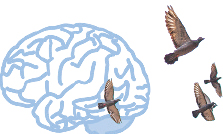
Think Like a SCIENTIST
Can you be classified as right-

The Think Like a Scientist Immersive Learning Activities are designed to teach and develop a skill set that will persist long after the final exam grades are recorded. We hope to develop a set of transferable skills that can be applied to analyzing dubious claims in any subject area—
Contagious Online Emotions (Chapter 1)
The Right Brain Versus the Left Brain (Chapter 2)
ESP (Chapter 3)
Multitasking (Chapter 4)
Positive and Negative Reinforcement (Chapter 5)
Eyewitness Testimony (Chapter 6)
Brain Exercises (Chapter 7)
Lie Detection (Chapter 8)
Learning Environments (Chapter 9)
Employment-
Related Personality Tests (Chapter 10) Online Dating (Chapter 11)
Coping with Stress (Chapter 12)
Tracking Mental Illness Online (Chapter 13)
Ketamine (Chapter 14)
New Myth or Science? Feature
Students often come to the introductory psychology course with misperceptions about psychological science. Our new Myth or Science? feature will help dispel some of these popular but erroneous beliefs.
MYTH SCIENCE
Is it true that multitasking is an efficient way to get things done?
Each chapter begins with a list of “Is It True?” questions that reflect popular myths about human behavior. These statements were tested with market research to see what percentage of students actually endorsed them. In some cases, agreement reached astonishing levels. For example, in one survey, more than 85% of students agreed that “the right brain is creative and intuitive, and the left brain is analytic and logical” and that “some people are left-
After being posed at the beginning of the chapter, each question is answered in the body of the chapter. A margin note signals the student to find the explanation and indicates whether the statement is “myth” or “science.”
New Data Presentation Program
Our new co-
New Research Methods Section in Chapter 1
Introductory chapters have a reputation for being dry and boring. Instructors, though, know that there are few alternatives: history and methods need to be taught before plunging into content-
The new end-
All-
Today’s college students are digital natives. They are accustomed to going online to seek answers and to connect with friends, fellow students, and their instructors. Past editions of Discovering Psychology provided a wealth of online resources for students, but the new seventh edition marks a step to a new level of digital integration with LaunchPad.
LaunchPad, our new course space, combines an interactive e-

The Latest Psychological Science
As was the case with previous editions, we have extensively updated every chapter with the latest research. We have pored over dozens of journals and clicked through thousands of Web sites to learn about the latest in psychological science. As a result, this new edition features scores of new topics. Just to highlight a few additions, the seventh edition includes brand-
In addition, we have significantly updated coverage of neuroscience and expanded our coverage of culture, gender, and diversity throughout the text. DSM-
As of our last count, there are over 1,000 new references in the seventh edition of Discovering Psychology, more than half of which are from 2013, 2014, or 2015. These new citations reflect the many new and updated topics and discussions in the seventh edition of Discovering Psychology. From the effects of social media and multitasking on student success to the latest discoveries about oxytocin, aggression, stress and telomeres, or the effectiveness of meditation in controlling pain and improving attention, our goal is to present students with interesting, clear explanations of psychological science. Later in this preface, you’ll find a list of the updates by chapter.
New Design, New Photos
Created with today’s media-
Connections to the American Psychological Association’s Guidelines for the Undergraduate Psychology Major
The American Psychological Association has developed the APA Guidelines for the Undergraduate Psychology Major: Version 2.0 to provide “optimal expectations for performance” by undergraduate psychology students. The APA Guidelines include five broad goals, which are summarized below. This table shows how Hockenbury, Nolan, and Hockenbury’s Discovering Psychology, Seventh Edition, helps instructors and students achieve these goals.
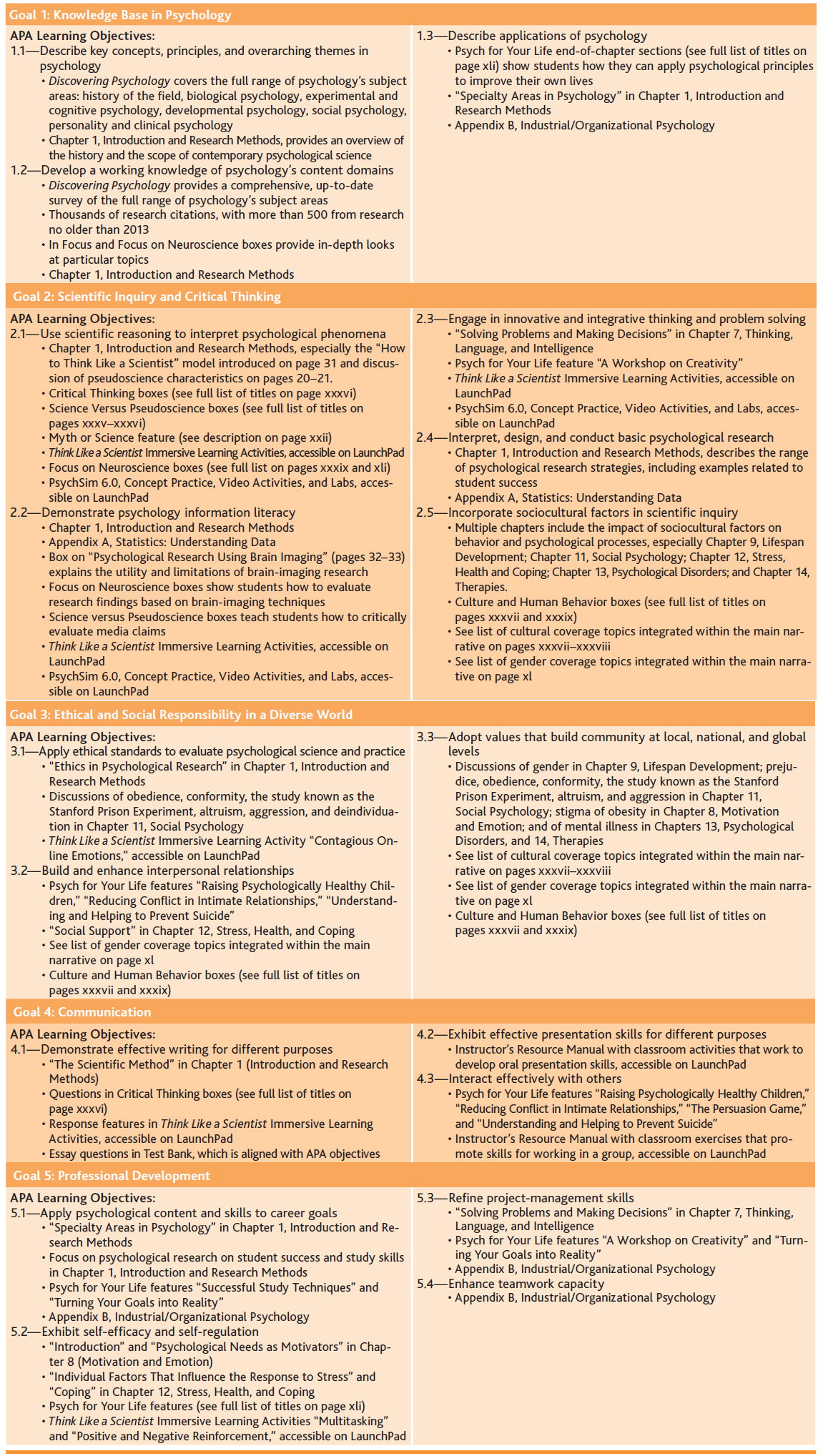
Major Chapter Revisions
As you page through our new edition, you will encounter new examples, boxes, photos, and illustrations in every chapter. Below are highlights of some of the most significant changes:
CHAPTER 1, INTRODUCTION AND RESEARCH METHODS
New Prologue, “The First Exam,” focusing on test experiences and student study strategies
New chapter introduction incorporating psychology’s goals
New photo example of the topics that psychologists study
New photo examples of the biological perspective and studying behavior from different psychological perspectives
Page xxviNew summary table and graphs showing specialty areas and employment settings for psychologists
“What Is Cross-
Cultural Psychology?” box streamlined and updated with new discussion of rice- cultivation versus wheat- cultivation cultures in China New student-
focused research examples and photo illustrations of concepts in research methods, including forming a hypothesis and meta- analysis New example of how to read a journal reference
Revised and updated Science Versus Pseudoscience box
New example of naturalistic observation
New student-
focused example of survey research using the National Survey of Student Engagement, including results comparing study habits of different majors New section on correlational studies, using research on Facebook likes and student study behaviors and strategies to illustrate correlations
New explanation of experimental methods, using an experiment on the testing effect to illustrate the key terms and important concepts of experimental design
New Critical Thinking box, “How to Think Like a Scientist,” introducing a four-
step model for scientific thinking that students can apply to any claim or belief New photo example of functional magnetic resonance imaging Discussion of use of animals in research moved into main text, illustrated with new photo example
Entirely new “Psych for Your Life” application that provides six research-
based study techniques to enhance student success. Along with providing helpful information right at the beginning of the semester, the application demonstrates the value and relevance of psychological research.

CHAPTER 2, NEUROSCIENCE AND BEHAVIOR
Added information in Figure 2.1 about the structure of sensory neurons
New photo of neuron and new research on the functions of glial cells and myelin
Streamlined discussions of communication within the neuron, the action potential, and communication between neurons
New photo of electrical impulses in the brain
Discussion of important neurotransmitters expanded to include glutamate, now a boldfaced key term
Endorphins discussion integrated into main text and illustrated with photo rather than discussed in a separate Focus on Neuroscience box
New photo examples of botox, dopamine, and Parkinson’s Disease
New photo showing cross section of peripheral nerve
Expanded discussion of oxytocin, now a boldfaced key term, with coverage of research on its diverse effects on social motivation and behavior
Coverage of “The 10% Myth” now integrated into text
Updated and streamlined discussion of plasticity and neurogenesis, now integrated into a single section and including 2013 research on carbon-
14 dating of new neuron New photo and updated research on Phineas Gage’s injury Simplified illustration of cerebral cortex lobes
Revised and updated Critical Thinking box, “‘His’ and ‘Her’ Brains?”
Revised and updated Science Versus Pseudoscience box, “Brain Myths,” includes new research on brain lateralization
Updated research and new photo in Psych for Your Life: Maximizing Your Brain’s Potential
CHAPTER 3, SENSATION AND PERCEPTION
Streamlined and updated box on subliminal perception
Focus on Neuroscience “Vision, Experience, and the Brain” revised and updated with 2015 research
New photo example of color blindness
Revised figure clarifying human auditory structures and process of hearing
Added discussion of cochlear implants, with photo illustration
Added information about the dangers of noise exposure in everyday life and from personal music players
New example of how frogs without outer ears detect sound
New cross-
cultural research on the language of smell in non- Western groups Revised In Focus box “Do Pheromones Influence Human Behavior?” that includes new 2013 and 2014 research on human chemosignals
New cross-
cultural research on effects of ethnicity and culture on pain perception, illustrated with photo Revised and updated Critical Thinking box, “ESP: Can Perception Occur Without Sensation?”
Added discussion of color constancy, now a boldfaced term
New In Focus box, “The Dress That Broke the Internet” explains why some people see “The Dress” as blue and black and others as gold and white
New drawings illustrating the Müller-
Lyer illusion and the Shepard Tables illusion Dramatic new photos illustrating Gestalt principles of organization, monocular cues, stroboscopic motion, and the moon illusion
Updated Psych for Your Life, including new research on the effectiveness of acupuncture in pain control

CHAPTER 4, CONSCIOUSNESS AND ITS VARIATIONS
Streamlined discussion of circadian rhythms and the suprachiasmatic nucleus
Updated research on multitasking, including 2014 data on cell phone usage contributing to motor vehicle accidents
New research and photo on the effects of artificial light, including computer and tablet screens, on circadian rhythms
Streamlined In Focus box, “What You Really Want to Know About Sleep”
Updated section, “Why Do We Sleep?”
New section on “Sleep and Memory Formation”
Updated, reorganized, and streamlined discussion of “Dreams and Mental Activity During Sleep”
Condensed Focus on Neuroscience, “The Dreaming Brain”
Updated information on the perils of driving while drowsy
Streamlined coverage of sleep disorders and hypnosis
New photo and caption tells the story of a young woman with narcolepsy
New coverage of exploding head syndrome
Updated and condensed Critical Thinking box on theories of hypnosis
Discussion of meditation updated with new research, including 2015 research on the effects on working memory and attention in U.S. military personnel
“Drug abuse” has been changed to “Substance Abuse Disorder” and definition has been revised to conform with DSM-
5 language; requirement that legal problems be present has been dropped, and requirement that craving be present has been added Page xxviiiUpdated data noting that most overdose deaths are now due to legal prescription drugs rather than illegal drugs
New photos of emergency medical workers, illustrating the dangers of alcohol abuse, and Cory Monteith, illustrating the dangers of depressant drugs
The term opiates replaced with the more accurate term opioids
Updated 2015 research on the surge in heroin and prescription opioid overdose deaths
New discussion of e-
cigarettes, including photo example Updated 2014 research on the therapeutic use of psychedelic drugs and ketamine
Updated information on the legal use of medical marijuana, including 2014 research on data showing fewer opioid overdose deaths in states with legal access to medical marijuana for pain treatment
Added 2015 research on long-
term mental health effects of psychedelic drug use Psych for Your Life section retitled “Overcoming Insomnia”

CHAPTER 5, LEARNING
New photo examples of learning, Ivan Pavlov, primary and conditioned reinforcers, media response to Skinner’s work, superstitious rituals, learned helplessness, applications of operant conditioning, and observational learning
Streamlined discussion of John B. Watson and introduction to behaviorism
New contemporary photo example of classical conditioning in advertising
2014 research suggesting a second identification for the infant in the famous “Little Albert” study, Albert Barger Martin
Condensed and simplified presentation of Robert Rescorla’s classic research
Revised section on taste aversions
Replaced reinforcement example of hitting a vending machine with pushing the coin-
return lever In text and tables, replaced the terms “punishment by application” and “punishment by removal” with “positive punishment” and “negative punishment”
Revised graphs showing schedules of reinforcement and response patterns
New historical photo of Keller and Marian Breland
Streamlined and updated Focus on Neuroscience, “Mirror Neurons: Imitation in the Brain”
New 2013 research example of observational learning in animals
New 2014 research on media effects on behavior, identifying a correlational link between a decrease in teen birth rates and viewership of an MTV reality series showing the struggles of teenage parents
Revised and updated Critical Thinking Box, “Does Exposure to Media Violence Cause Aggressive Behavior?” includes 2015 research on the effects of violent video games
CHAPTER 6, MEMORY
Revised art demonstrating Baddeley’s model of working memory
New tip-
of- the- tongue examples Revised discussion of flashbulb memories updated with 2015 research and new photo illustration
Revised graph showing the Ebbinghaus forgetting curve
New photo examples of the the interaction of memory stages in everyday life, types of information stored in long-
term memory, retrieval cues, culture’s effects on early memory, “tip- of- the- fingers” experience, and motivated forgetting Page xxixUpdated example of eyewitness misidentification, with new illustration
New 2013 research, conducted by the online magazine Slate, showing how faked news photographs can produce false memories about political events
New coverage of false confessions includes 2015 research and real-
world data from the Innocence Project New photo of David Snowden with an elderly participant in the Nun Study of Aging and Alzheimer’s Disease
New photos of Suzanne Corkin, Henry Molaison (the famous “H.M.”), and of a virtual model of H.M.’s damaged brain based on new 2014 research
In Focus box “H.M. and Famous People” eliminated
Fully revised Psych for Your Life application, “Ten Steps to Boost Your Memory” and new photo of memory superstar and journalist Joshua Foer
CHAPTER 7, THINKING, LANGUAGE, AND INTELLIGENCE
The new term autism spectrum disorder has replaced autism and Asperger’s syndrome in the Prologue and throughout the chapter to conform to the DSM-
5 classification Critical Thinking box “The Persistence of Unwarranted Beliefs” updated with 2015 research
Culture and Human Behavior box “The Effect of Language on Perception” updated with 2015 research
New 2014 research example added to discussion of animal cognition
The term intellectual disability has replaced mental retardation in the In Focus box “Neurodiversity: Beyond IQ” to conform to new DSM-
5 terminology Updated research on problem-
solving strategies New extended example of functional fixedness—
repurposing plastic bags and bottles into useful objects— illustrated with new photo Confirmation bias introduced as a boldfaced term
Updated discussion of practical intelligence
New photo examples of items that don’t match the prototype, decision-
making strategies, sign language, and Gardner’s theory of multiple intelligences Updated discussion of stereotype threat
New photo example of creativity: Steve Jobs
CHAPTER 8, MOTIVATION AND EMOTION
New prologue, “One Step, One Breath,” about one of the authors’ experiences as a volunteer trekking through a remote region of the Himalayas
Revised, condensed, and streamlined introduction to motivational theories
New photo examples of sensation seekers, achievement motivation, emotion, arousal and intense emotion, the facial feedback hypothesis, and appraisal and emotion
Condensed, simplified, and updated section on hunger and eating
New examples of how culture shapes food choices
New information about body mass index and alternative measures of obesity
New data on the role that globalization plays in the increase in obesity in developing countries worldwide
Updated Critical Thinking box “Has Evolution Programmed Us to Overeat?” including 2014 research on stigma associated with obesity
2014 research on the decrease in physical activity levels in the United States over the past decade
New photo of Masters and Johnson
Page xxxEvolution and mate preferences now covered within the main text in Chapter 9, Lifespan Development
Focus on Neuroscience, “Romantic Love and the Brain” no longer included in chapter
Revised introduction to “Psychological Needs as Motivators” section
Updated research on self-
determination theory New example of achievement motivation
Updated research on the functions of emotion and emotional intelligence
Streamlined and updated discussion of the subjective experience of emotion and the neuroscience of emotion, including new photo example
Gender and emotion now covered within the main text in the retitled section, “Culture, Gender, and Emotional Experience”
New figure based on 2014 cross-
cultural research on the association of different emotions with specific physical sensations New photo of William James
Updated research on cognitive theories of emotion

CHAPTER 9, LIFESPAN DEVELOPMENT
New prologue about a young transgender man, James, growing up in a small town in rural New York
Revised introduction, with new discussion of longitudinal and cross-
sectional research designs; longitudinal design and cross- sectional design are new key terms New photo examples of continuity and change over the lifespan
New photo of X and Y chromosomes
Expanded and updated discussion of research on the epigenetic effects of early life stress in human subjects
New photo and discussion of Harry Harlow’s classic “contact comfort” research and its role in attachment
New photos of Mary Ainsworth and Erik Erikson
Fully revised section on theories of gender-
role development now includes evolutionary and interactionist theories New photo examples of gender-
stereotyped toys Mate preferences now covered here
New section on gender identity
New photo examples of cognitive development and Piagetian stages
Updated statistics on U.S. households, including changes in family structure
New discussion of the new phenomenon of “boomerang kids”

CHAPTER 10, PERSONALITY
New photo of Carl Jung and streamlined discussion of archetypes
Streamlined discussion of Freud and his theory drops bolded terms Eros and Thanatos
Discussion of Alfred Adler’s theory of personality updated with new research
Many new photo examples, including Freud’s influence on popular culture, establishing the superego, sublimation, the Oedipus complex, the question of innate good or evil, the TAT, and self-
efficacy New cross-
cultural photo illustration for Critical Thinking box, “Freud Versus Rogers on Human Nature” Slightly shortened discussion of the humanistic perspective
Page xxxiStreamlined and updated Science Versus Pseudoscience box on graphology
Streamlined Focus on Neuroscience, “The Neuroscience of Personality”
In Focus box, “Explaining Those Amazing Identical Twin Similarities,” dropped from chapter
Streamlined discussion of self-
efficacy with new student- centered example New 2014 and 2015 research on the trait perspective
Section on self-
report inventories updated with 2015 research

CHAPTER 11, SOCIAL PSYCHOLOGY
Discussion of person perception updated with new research on the role of person perception in social media
New photo example of implicit personality theory
Streamlined Focus on Neuroscience, “Brain Reward When Making Eye Contact with Attractive People”
Revised introduction to attribution
New photo example of blaming the victim—
the story of Elizabeth Smart Condensed Culture and Human Behavior box, “Explaining Failure and Murder”
Revised discussion of cognitive dissonance, with new examples and research on cognitive dissonance in preschoolers and capuchin monkeys
Updated In Focus box, “Interpersonal Attraction and Liking”
Revised and updated discussion of in-
group bias; ethnocentricity no longer a bolded key term Updated discussion of implicit attitudes, including 2015 research
Expanded and updated discussion of prejudice, incorporating new research and neuroscience evidence
Revised and updated section on Milgram’s obedience study, including new discussion of contemporary replication
Updated and revised Critical Thinking box, “Abuse at Abu Ghraib,” including critiques of Zimbardo’s study known as the Stanford Prison Experiment
New section, “Altruism and Aggression,” includes expanded coverage of Latané and Darley’s research on bystander intervention, additional factors that increase the likelihood of bystanders helping, and entirely new section on aggression
New figures on aggression and the brain, and the influence of sociocultural factors on aggression
New photos and captions provide contemporary examples of the self-
serving bias, the effect of attitudes on behavior, research linking prejudice and negative emotion, destructive obedience of authority, prosocial behavior, coming to the aid of a stranger, road rage, and the rule of reciprocity
CHAPTER 12, STRESS, HEALTH, AND COPING
New photo examples of stress and appraisal, uncontrollable events, explanatory style, Type A behavior pattern, and providing social support
Introduction now includes data from an APA survey on stress in America
“Sources of Stress” updated with 2013, 2014, and 2015 research
Streamlined Culture and Human Behavior box
Introduction to “Physical Effects of Stress” updated with 2014 research
“Stress, Chromosomes, and Aging” updated with 2014 and 2015 research
Revised and updated discussion of psychological factors in the response to stressors
Page xxxiiNew research example demonstrating the importance of relationships in the ability to deal with stressors
New prologue example in the In Focus box, “Providing Effective Social Support”
Streamlined and updated introduction to “Coping”
Streamlined In Focus box, “Gender Differences in Responding to Stress”
New cross-
cultural photo examples of major life events, daily hassles and stress, daily hassles, the benefits of social support, and problem- focused coping Photos of Richard Lazarus and Janice Kiecolt-
Glaser dropped

CHAPTER 13, PSYCHOLOGICAL DISORDERS
New Prologue about the psychotic break and successful life of a woman with schizophrenia—
Elyn Saks Expanded coverage of the DSM-
5, presenting a history of the manual, including critiques Sample DSM diagnostic criteria figure dropped
New coverage of the World Health Organization’s International Classification of Diseases
New photo example demonstrates the importance of context in differentiating normal and abnormal behavior
Critical Thinking box updated with new research on violence and mental illness
Updated cross-
cultural research on prevalence of psychological disorders and treatment rates in developing countries Revised Table of Key Diagnostic Categories, incorporating DSM-
5 terminology and criteria Revised introduction to “Anxiety Disorders,” incorporating DSM-
5 criteria for posttraumatic stress disorder and obsessive- compulsive disorder New evolutionary discussion of phobias
New phobia example—
Oprah Winfrey’s fear of chewing gum Section on social phobia retitled “Social Anxiety Disorder” to conform to DSM-
5 terminology, and criteria updated with new research, including cross- cultural research Reorganized and updated sections on postraumatic stress disorder and obsessive-
compulsive disorder, incorporating DSM- 5 criteria New cross-
cultural research on posttraumatic stress disorder in children living in the Middle East New research on how posttraumatic stress disorder symptoms can be triggered by reports in the news media and by events unrelated to the original trauma
Updated research on the role played by pre-
existing vulnerability in the development of posttraumatic stress disorder Section on “Mood Disorders” retitled as “Disordered Moods and Emotions: Depressive Disorder and Bipolar Disorder” to conform to new DSM-
5 terminology New discussion of DSM-
5’s controversial removal of “the bereavement exclusion” that excluded symptoms caused by bereavement as criteria for depression Updated longitudinal research on the prevalence and recurrence of major depressive disorder over the lifespan
Section on major depressive disorder updated with new examples and 2014 and 2015 research
New research on cultural differences related to major depressive disorder
New example to introduce bipolar disorder
Updated 2014 and 2015 research on the causes of depressive and bipolar disorders
Updated Critical Thinking box “Does Smoking Cause Depression and Other Psychological Disorders?” includes revised graph
Page xxxiiiRevised table of depressive and bipolar disorders, incorporating DSM-
5 terminology and criteria “Eating Disorders” section expanded and updated to incorporate DSM-
5 terminology and criteria, including a new section on the newly described disorder “binge- eating disorder” Updated discussion of personality disorders introduces second approach to classification
New discussion of the differences among the categories psychopath, sociopath, and antisocial personality disorder, with new photo examples
Updated research on borderline personality disorder
Updated 2014 research on the controversy surrounding the authenticity of dissociative identity disorder
Revised table of dissociative disorders, incorporating DSM-
5 terminology and criteria Fully revised section on schizophrenia, including new examples, extended coverage of variations of symptoms across cultures, and a cross-
cultural look at prevalence New photo example of the Truman Show delusion as a culturally-
specific symptom of schizophrenia New photo examples of people with major depressive disorder, bipolar disorder, and schizophrenia
Psych for Your Life application on understanding and helping to prevent suicide updated with new statistics
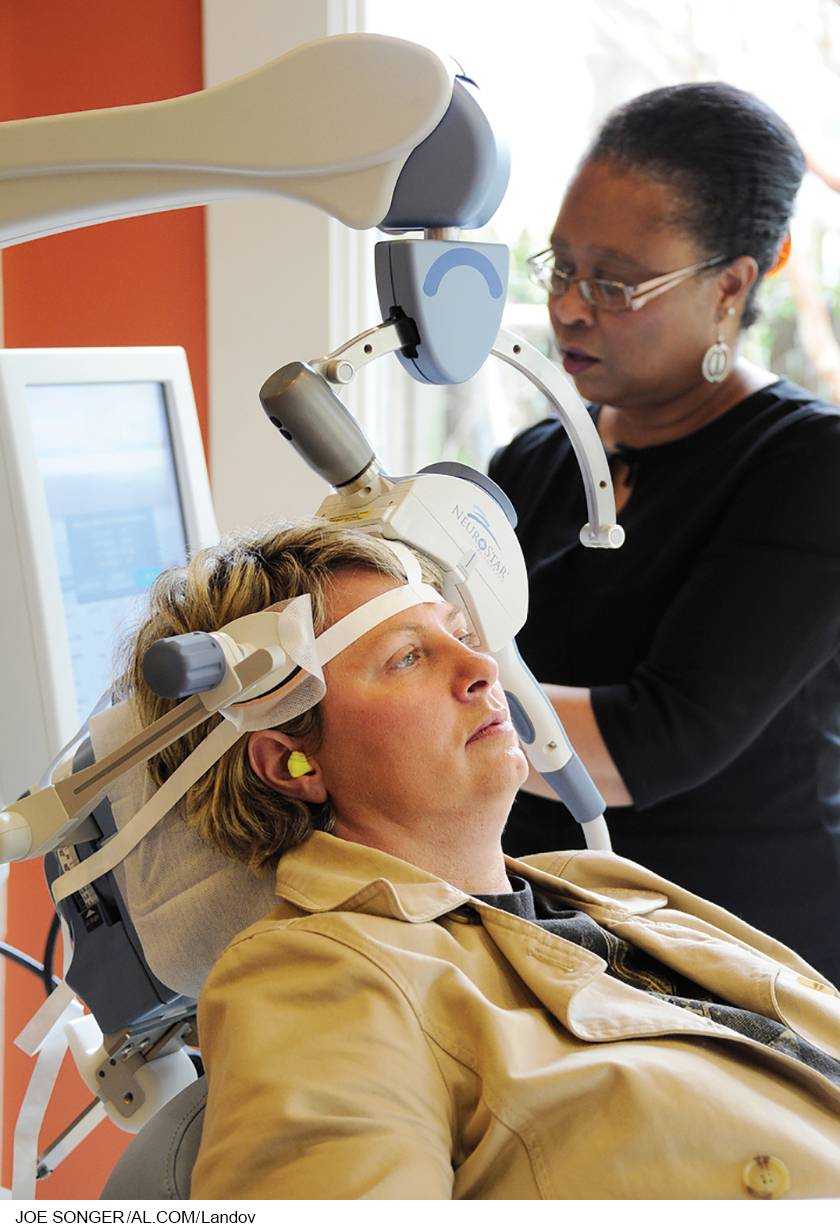
CHAPTER 14, THERAPIES
Terminology revised throughout to reflect DSM-
5 criteria and diagnostic labels Streamlined discussion of short-
term dynamic therapies Discussion of EMDR and exposure therapies moved into main text, in retitled section “Systematic Desensitization and Exposure Therapies”
Updated 2013 and 2014 research on token economies and contingency management therapies
Discussion of Albert Ellis’s work updated to note “rational-
emotive therapy” now renamed “rational- emotive behavior therapy” Updated coverage of cognitive therapy
Updated section “Cognitive-
Behavioral Therapy and Mindfulness- Based Therapies,” including 2014 research on the use of cognitive- behavioral therapy with clients with schizophrenia to help treat psychotic symptoms New In Focus box, “Increasing Access: Meeting the Need for Mental Health Care,” introduces the role of paraprofessionals and lay counselors worldwide, plus technology-
driven solutions Expanded and updated discussion, “Evaluating the Effectiveness of Psychotherapy,” includes criteria to evaluate new therapies
Updated research on antipsychotic medications, including information from the newest edition of the Primer of Drug Action
Updated table on antidepressant medications
New Critical Thinking box, “Do Antidepressants Work Better Than Placebos?”, examines the effectiveness of antidepressants
New discussions of the experimental use of MDMA to treat anxiety disorders and PTSD and of ketamine to treat major depressive disorder, incorporating 2014 research
All-
new Focus on Neuroscience, “Psychotherapy and the Brain,” presents research comparing the effect of antidepressant and psychotherapy treatment on brain activity in people with major depressive disorder Page xxxivUpdated research on electroconvulsive therapy and new, experimental treatments
New photo examples of the varied workplaces of psychologists, Native American healing, transcranial magnetic stimulation, mindfulness-
based stress reduction, the stigma associated with psychological problems, and technology- based solutions to expanding access to mental health care
APPENDIX B: INDUSTRIAL/ORGANIZATIONAL PSYCHOLOGY
New photo examples of human factors involved in the use of workplace equipment, matching job and applicant, leadership, different work styles, work—
life balance, and teleworking
Features of Discovering Psychology
For all that is new in the seventh edition, we were careful to maintain the unique elements that have been so well received in the previous editions. Every feature and element in our text was carefully developed and serves a specific purpose. From comprehensive surveys, input from reviewers, and our many discussions with faculty and students, we learned what elements people wanted in a text and why they thought those features were important tools that enhanced the learning process. We also surveyed the research literature on text comprehension, student learning, and memory. In the process, we acquired many valuable insights from the work of cognitive and educational psychologists. Described below are the main features of Discovering Psychology and a discussion of how these features enhance the learning process.
Associate the new with the old in some natural and telling way, so that the interest, being shed along from point to point, fully suffuses the entire system of objects. . . . Anecdotes and reminiscences [should] abound in [your] talk; and the shuttle of interest will shoot backward and forward, weaving the new and the old together in a lively and entertaining way.
—William James, Talks to Teachers (1899)
The Narrative Approach
As you’ll quickly discover, our book has a very distinctive voice. From the very first page of this text, the reader comes to know us as people and teachers through carefully selected stories and anecdotes. Some of our friends and relatives have also graciously allowed us to share stories about their lives. The stories are quite varied—
The stories we tell reflect one of the most effective teaching methods: the narrative approach. In addition to engaging the reader, each story serves as a pedagogical springboard to illustrating important concepts and ideas. Every story is used to connect new ideas, terms, and ways of looking at behavior to information with which the student is already familiar.
Prologues
As part of the narrative approach, every chapter begins with a Prologue, a true story about ordinary people with whom most students can readily identify. The Prologue stories range from the experiences of a teenager with Autism Spectrum Disorder to people struggling with the aftereffects of a devastating wildfire to the story of a man who regained his sight after decades of blindness. Each Prologue effectively introduces the chapter’s themes and lays the groundwork for explaining why the topics treated by the chapter are important. The Prologue establishes a link between familiar experiences and new information—
Logical Organization, Continuity, and Clarity
As you read the chapters in Discovering Psychology, you’ll see that each one tells the story of a major topic in a logical way that flows continually from beginning to end. Themes are clearly established in the first pages of the chapter. Throughout the chapter, we come back to those themes as we present subtopics and specific research studies. Chapters are thoughtfully organized so that students can easily see how ideas are connected. The writing is carefully paced to maximize student interest and comprehension. Rather than simply mentioning terms and findings, we explain concepts clearly. And we use concrete analogies and everyday examples, rather than vague or flowery metaphors, to help students grasp abstract concepts and ideas.
Paradoxically, one of the ways that we maintain narrative continuity throughout each chapter is through the use of in-
Traumatic Brain Injury: From Concussions to Chronic Traumatic Encephalopathy, p. 54
Do Pheromones Influence Human Behavior?, p. 103
The Dress That Broke the Internet, p. 122
What You Really Want to Know About Sleep, p. 141
What You Really Want to Know About Dreams, p. 152
Watson, Classical Conditioning, and Advertising, p. 190
Evolution, Biological Preparedness, and Conditioned Fears: What Gives You the Creeps?, p. 195
Changing the Behavior of Others: Alternatives to Punishment, p. 202
Déjà-Vu Experiences: An Illusion of Memory?, p. 246
Does a High IQ Score Predict Success in Life?, p. 293
Neurodiversity: Beyond IQ, p. 298
Detecting Lies, p. 339
Hooking Up on Campus, p. 397
Interpersonal Attraction and Liking, p. 463
Providing Effective Social Support, p. 521
Gender Differences in Responding to Stress: “Tend-
and- Befriend” or “Fight- or- Flight?,” p. 525 Using Virtual Reality to Treat Phobia and Posttraumatic Stress Disorder, p. 596
Increasing Access: Meeting the Need for Mental Health Care, p. 606
Servant Leadership: When It’s Not All About You, p. B-10
Name, Title, Generation, p. B-11

Scientific Emphasis
Many first-
Because we carefully guide students through the details of specific experiments and studies, they develop a solid understanding of how scientific evidence is gathered and the interplay between theory and research. And because we rely on original rather than secondary sources, students get an accurate presentation of both classic and contemporary psychological studies.
One unique way that we highlight the scientific method in Discovering Psychology is with our trademark Science Versus Pseudoscience boxes. In these boxes, students see the importance of subjecting various claims to the standards of scientific evidence.
These boxes promote and encourage scientific thinking by focusing on topics that students frequently ask about in class. The seventh edition of Discovering Psychology includes the following Science Versus Pseudoscience boxes:
What Is a Pseudoscience?, pp. 20-21
Phrenology: The Bumpy Road to Scientific Progress, p. 61
Brain Myths, p. 77
Subliminal Perception, p. 89
Can a DVD Program Your Baby to Be a Genius?, pp. 372-373
Graphology: The “Write” Way to Assess Personality?, p. 443

Critical Thinking Emphasis
Another important goal of Discovering Psychology is to encourage the development of critical thinking skills. To that end, we do not present psychology as a series of terms, definitions, and facts to be skimmed and memorized. Rather, we try to give students an understanding of how particular topics evolve. In doing so, we also demonstrate the process of challenging preconceptions, evaluating evidence, and revising theories based on new evidence. In short, every chapter shows the process of psychological research—
Because we do not shrink from discussing the implications of psychological findings, students come to understand that many important issues in contemporary psychology are far from being settled. Even when research results are consistent, how to interpret those results can sometimes be the subject of considerable debate. As the authors of the text, we very deliberately try to be evenhanded and fair in presenting both sides of controversial issues. In encouraging students to join these debates, we often challenge them to be aware of how their own preconceptions and opinions can shape their evaluation of the evidence.
Beyond discussions in the text proper, every chapter includes one or more Critical Thinking boxes. These boxes are carefully designed to encourage students to think about the broader implications of psychological research—
How to Think Like a Scientist, p. 31
“His” and “Her” Brains?, p. 72
ESP: Can Perception Occur Without Sensation?, p. 112
Is Hypnosis a Special State of Consciousness?, pp. 158—159
Is Human Freedom Just an Illusion?, p. 204
Does Exposure to Media Violence Cause Aggressive Behavior?, p. 219
The Memory Wars: Recovered or False Memories?, pp. 254—255
The Persistence of Unwarranted Beliefs, pp. 284—285
Has Evolution Programmed Us to Overeat?, p. 322
Emotion in Nonhuman Animals: Laughing Rats, Silly Elephants, and Smiling Dolphins?, pp. 344-345
The Effects of Child Care on Attachment and Development, p. 401
Freud Versus Rogers on Human Nature, p. 430
Abuse at Abu Ghraib: Why Do Ordinary People Commit Evil Acts?, pp. 480–481
Do Personality Factors Cause Disease?, p. 518
Are People with a Mental Illness as Violent as the Media Portray Them?, pp. 536–537
Does Smoking Cause Major Depressive Disorder and Other Psychological Disorders?, pp. 556–557
Do Antidepressants Work Better Than Placebos?, pp. 622-623
Cultural Coverage
As you can see in Table 1, we weave cultural coverage throughout many discussions in the text. But because students are usually unfamiliar with cross-
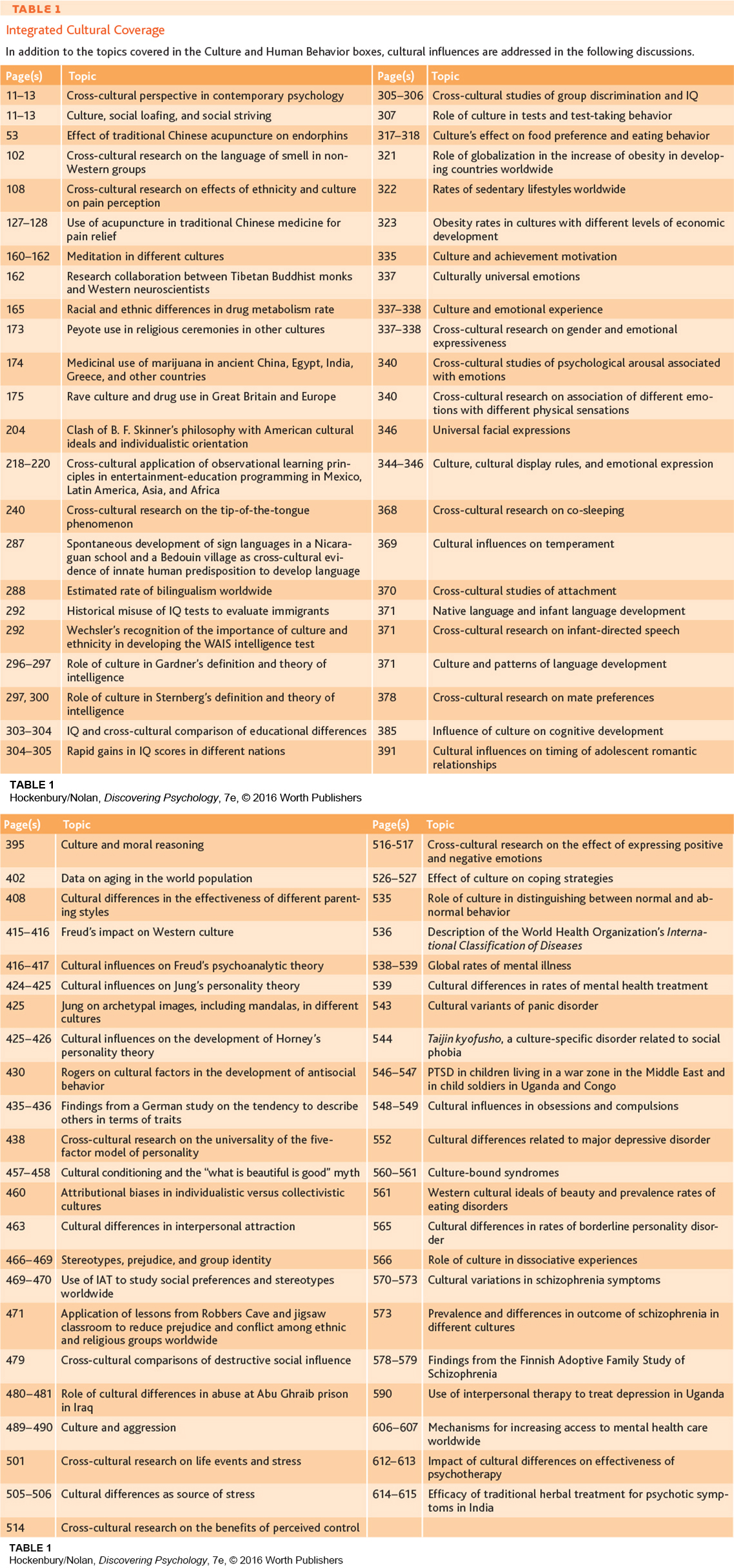
What Is Cross-
Cultural Psychology?, p. 12 Ways of Seeing: Culture and Top-
Down Processes, p. 115 Culture and the Müller-
Lyer Illusion: The Carpentered- World Hypothesis, p. 126 Culture’s Effects on Early Memories, p. 237
Page xxxixThe Effect of Language on Perception, pp. 286-287
Performing with a Threat in the Air: How Stereotypes Undermine Performance, pp. 304-305
Where Does the Baby Sleep?, p. 368
Explaining Failure and Murder: Culture and Attributional Biases, p. 460
The Stress of Adapting to a New Culture, p. 506
Culture-
Bound Syndromes, pp. 560—561 Cultural Values and Psychotherapy, p. 613
Gender Coverage
Gender influences and gender differences are described in many chapters. Table 2 below shows the integrated coverage of gender-
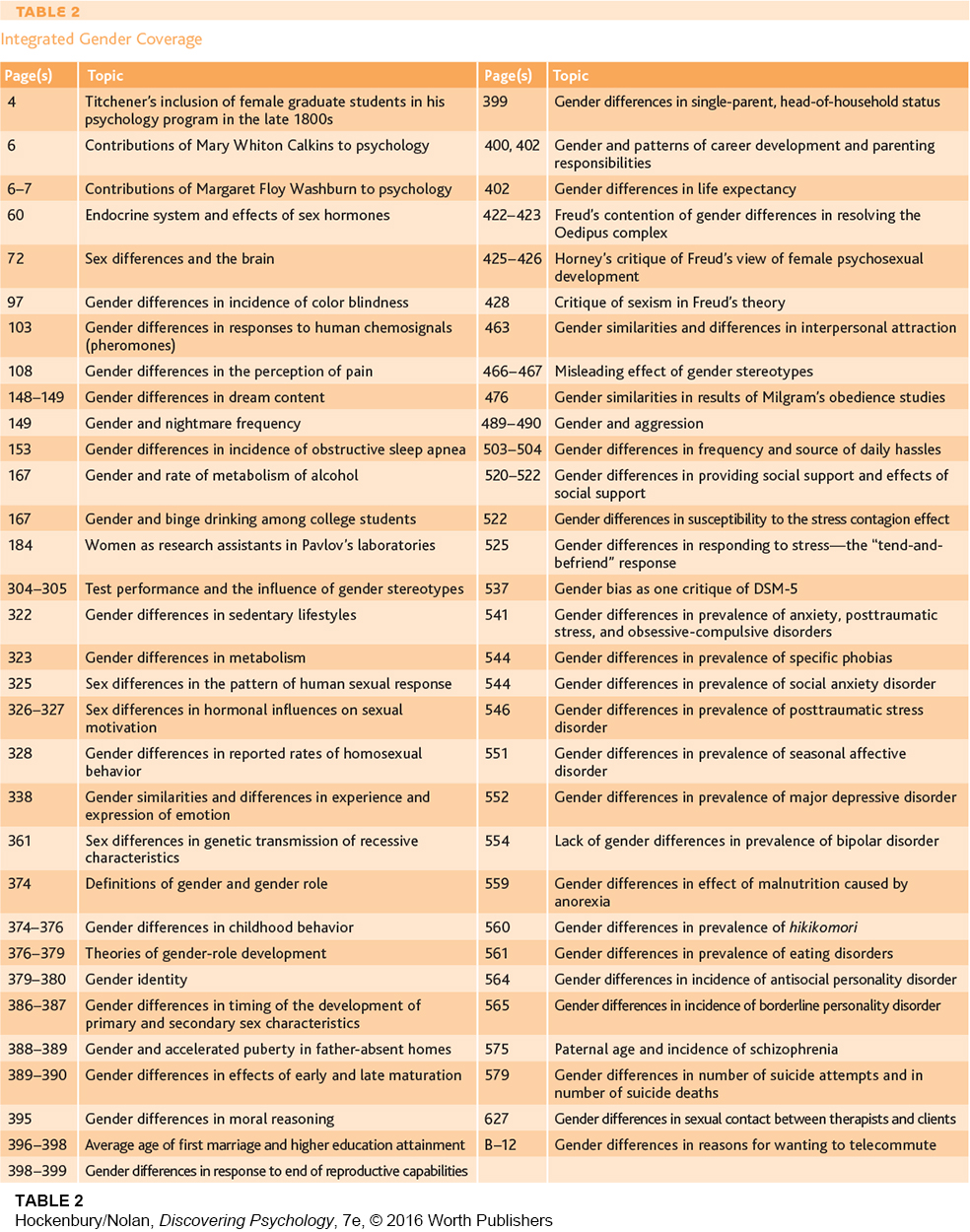
Neuroscience Coverage
Psychology and neuroscience have become intricately intertwined. Especially in the last decade, the scientific understanding of the brain and its relation to human behavior has grown dramatically. The imaging techniques of brain science—
Psychological Research Using Brain Imaging, pp. 32—33
Mapping the Pathways of the Brain, p. 62
Juggling and Brain Plasticity, p. 63
Vision, Experience, and the Brain, p. 95
The Sleep-
Deprived Emotional Brain, p. 146 The Dreaming Brain, p. 148
Meditation and the Brain, p. 163
The Addicted Brain: Diminishing Rewards, p. 166
How Methamphetamines Erode the Brain, p. 173
Mirror Neurons: Imitation in the Brain, p. 217
Assembling Memories: Echoes and Reflections of Perception, p. 258
Mapping Brain Changes in Alzheimer’s Disease, p. 264
Seeing Faces and Places in the Mind’s Eye, p. 274
Dopamine Receptors and Obesity, p. 324
Emotions and the Brain, p. 342
The Adolescent Brain: A Work in Progress, p. 388
Boosting the Aging Brain, p. 404
The Neuroscience of Personality: Brain Structure and the Big Five, p. 440
Brain Reward When Making Eye Contact with Attractive People, p. 458
The Mysterious Placebo Effect, p. 512
The Hallucinating Brain, p. 570
Schizophrenia: A Wildfire in the Brain, p. 577
Psychotherapy and the Brain, p. 621
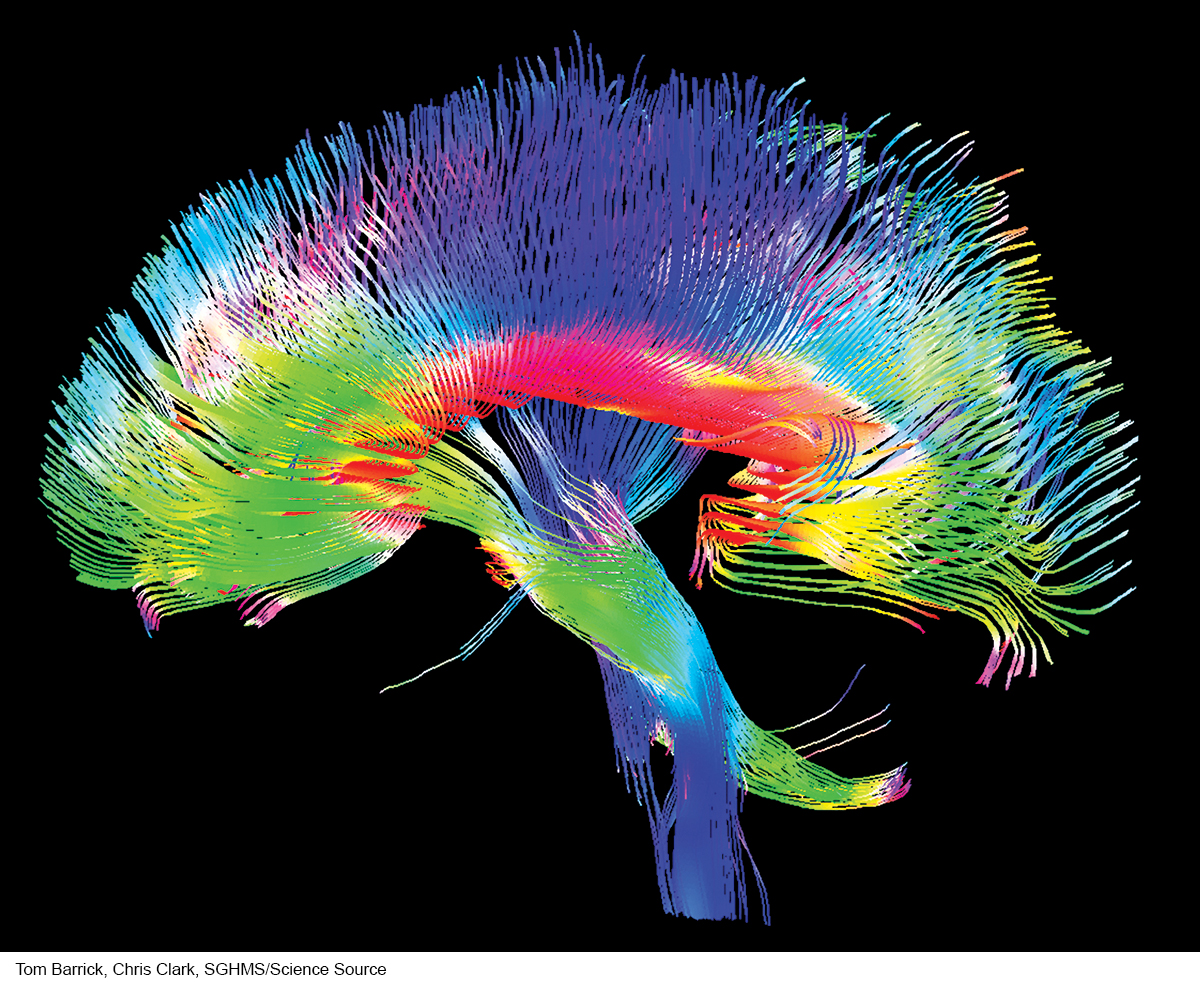
Psych for Your Life
Among all the sciences, psychology is unique in the degree to which it speaks to our daily lives and applies to everyday problems and concerns. The Psych for Your Life feature at the end of each chapter presents the findings from psychological research that address a wide variety of problems and concerns. In each of these features, we present research-
Successful Study Techniques, pp. 35–37
Maximizing Your Brain’s Potential, pp. 79–81
Strategies to Control Pain, pp. 127–129
Overcoming Insomnia, pp. 176–177
Using Learning Principles to Improve Your Self-
Control, pp. 221–222 Ten Steps to Boost Your Memory, pp. 265–267
A Workshop on Creativity, pp. 308–309
Turning Your Goals into Reality, pp. 351–353
Raising Psychologically Healthy Children, pp. 407–408
Possible Selves: Imagine the Possibilities, pp. 447–449
The Persuasion Game, pp. 491–492
Minimizing the Effects of Stress, pp. 527–529
Understanding and Helping to Prevent Suicide, pp. 579–581
What to Expect in Psychotherapy, pp. 625–627
The Pedagogical System
The pedagogical system in Discovering Psychology was carefully designed to help students identify important information, test for retention, and learn how to learn. It is easily adaptable to an SQ3R approach, for those instructors who have had success with that technique. As described in the following discussion, the different elements of this text form a pedagogical system that is very student-
We’ve found that it appeals to diverse students with varying academic and study skills, enhancing the learning process without being gimmicky or condescending. A special student preface titled To the Student on pages xlviii to li, immediately before Chapter 1, describes the complete pedagogical system and demonstrates how students can make the most of it.
The pedagogical system has four main components: (1) Advance Organizers, (2) Chapter Reviews, (3) Concept Maps, and (4) LaunchPad for Discovering Psychology, Seventh Edition. (You’ll learn more about the many features available in LaunchPad in the next section, “Multimedia to Support Teaching and Learning.”) Major sections are introduced by an Advance Organizer that identifies the section’s Key Theme followed by a bulleted list of Key Questions. Each Advance Organizer mentally primes the student for the important information that is to follow and does so in a way that encourages active learning. Students often struggle with trying to determine what’s important to learn in a particular section or chapter. As a pedagogical technique, the Advance Organizer provides a guide that directs the student toward the most important ideas, concepts, and information in the section. It helps students identify main ideas and distinguish them from supporting evidence and examples.

Journalist Joshua Foer (2011) visited a memory competition expecting to find people with special memory abilities. Instead, he encountered a group of “mental athletes”—people with ordinary minds who had trained their memories to accomplish incredible feats, such as reciting hundreds of random digits or pages of poetry. Told that anyone could develop an expert memory with training, he set out to prove it and devoted months to training his own memory. A year later, he won the USA Memory Championship and even set a new U.S. record by memorizing the position of a deck of cards in one minute, 40 seconds. Joshua’s secret? Mnemonic techniques, like the method of loci—
Several other in-
Concept Maps are visual reviews that encourage students to review and check their learning at the end of the chapter. The hierarchical layout shows how themes, concepts, and facts are related to one another. Chapter photos are included as visual cues to important chapter information.
Multimedia to Support Teaching and Learning
LaunchPad with LearningCurve Quizzing
A comprehensive Web resource for teaching and learning psychology, LaunchPad combines Worth Publishers’ awarding-
Discovering Psychology and LaunchPad can be ordered together with LP ISBN-

LaunchPad for Discovering Psychology includes all the following resources:
The LearningCurve quizzing system was designed based on the latest findings from learning and memory research. It combines adaptive question selection, immediate and valuable feedback, and a game-
like interface to engage students in a learning experience that is unique to them. Each LearningCurve quiz is fully integrated with other resources in LaunchPad through the Personalized Study Plan, so students will be able to review with Worth’s extensive library of videos and activities. And state- of- the- art question- analysis reports allow instructors to track the progress of individual students as well as their class as a whole. The interactive e-
Book allows students to highlight and bookmark the text, and to make their own notes, just as they would with a consumable printed textbook.Think Like a Scientist Immersive Learning Activities, authored by Susan Nolan and Sandy Hockenbury, place students in real-
world scenarios, asking them to think critically about scientific claims in the world around them. These active learning exercises combine video, audio, text, games, and assessment to help students hone and develop the scientific literacy skills they will use well beyond the introductory course. Concept Practice, created by award-
winning multimedia author Thomas Ludwig (Hope College), helps students solidify their understanding of key concepts. With these in- depth tutorials, students explore a variety of important topics, often in an experimental context in the role of either researcher or subject. Tutorials combine animations, video, illustrations, and self- assessment. Page xliiiPsychSim 6.0, thoroughly re-
imagined and retooled for the mobile web, is the new release of PsychSim by Thomas Ludwig (Hope College), using interactive videos, charts, and simulations to immerse students in the world of psychological research and placing them in the role of scientist or subject in activities that highlight important concepts, processes, and experimental approaches. Video Activities include more than 100 engaging video modules that instructors can easily assign and customize for student assessment. Videos cover classic experiments, current news footage, and cutting-
edge research, all of which are sure to spark discussion and encourage critical thinking. Labs offer interactive experiences that fortify the most important concepts and content of introductory psychology. In these activities, students participate in classic and contemporary experiments, generating real data and reviewing the broader implications of those findings. A virtual host makes this a truly interactive experience.
TheScientific American News Feed delivers weekly articles, podcasts, and news briefs on the very latest developments in psychology from the first name in popular science journalism.
Deep Integration is available between LaunchPad products and Blackboard, Brightspace by D2L, Canvas, and Moodle. These deep integrations offer educators single sign-
on and Gradebook sync now with auto- refresh. Also, these best- in- class integrations offer deep linking to all Macmillan digital content at the chapter and asset level, giving professors ultimate flexibility and customization capability within their LMS.
Instructor Supplements, Videos, and Presentation Resources
The Downloadable Instructor’s Resource Manual was prepared by Heather Jennings of Mercer County Community College, and revised by Matthew Isaak of University of Louisiana at Lafayette, with past contributions from Edna Ross, University of Louisville; Skip Pollock, Mesa Community College; Claudia Cochran-
Miller, El Paso Community College; Beth Finders, St. Charles Community College; Beverly Drinnin, Des Moines Area Community College; Wayne Hall, San Jacinto College— Central Campus; Nancy Melucci, Los Angeles Community College District; Paul DeMarco, University of Louisville; Julie Gurner, Community College of Philadelphia; Anne McCrea, Sinclair Community College; and Rachel Rogers, Community College of Rhode Island. Arranged topically rather than by chapter for this edition, the Downloadable Instructor’s Resource Manual includes an abundance of materials to aid instructors in planning their courses, including classroom demonstrations and activities, student exercises, advice on teaching the nontraditional student, popular video suggestions, and “Psychology in the News” topics. The lecture guides contain chapter objectives and outlines and suggestions on how to approach your lecture. The Downloadable Diploma Test Bank was written by Don and Sandra Hockenbury with the assistance of Cornelius Rea. This edition’s test bank was expertly revised by Sara Harris, Illinois State University. This enhanced Test Bank includes over 6,000 multiple-
choice, true- false, and short- answer essay questions, plus Learning Objectives for each chapter that correspond to those in the Instructor’s Resource Manual. Questions have also been keyed to several APA guidelines and learning outcomes for the undergraduate psychology major. Available for both Windows and Macintosh, the Test Bank files can be downloaded at macmillanhighered.com/Catalog/product/discoveringpsychology- seventhedition- hockenbury/instructorresources#tab Diploma is versatile dual-
platform test- generating software that allows instructors to edit, add, or scramble questions from the Discovering Psychology, Seventh Edition, Test Bank and to format tests, drag and drop questions to create quizzes quickly and easily, and then print them for an exam. The computerized Test Bank will also allow instructors to export into a variety of formats that are compatible with many Internet- based testing products. For more information on Diploma, please visit Blackboard’s Web site: https://blackboard.secure.force.com
Interactive Presentation Slides are another great way to introduce Worth’s dynamic media into the classroom without lots of advance preparation. Each presentation covers a major topic in psychology and integrates Worth’s high-
quality videos and animations for an engaging teaching and learning experience. These interactive presentations are complementary to adopters of Discovering Psychology and are perfect for technology novices and experts alike. The Video Anthology for Introductory Psychology includes over 150 unique video clips to bring lectures to life. Provided free of charge to adopters of Discovering Psychology, this rich collection includes clinical footage, interviews, animations, and news segments that vividly illustrate topics across the psychology curriculum.
The i>Clicker Classroom Response System is a versatile polling system developed by educators and for educators that makes class time more efficient and interactive. i> Clicker allows you to ask questions and instantly record your students’ responses, take attendance, and gauge students’ understanding and opinions. i>Clicker is available at a 10% discount when packaged with Discovering Psychology.
Acknowledgments
Many talented people contributed to this project. First, thanks to Elissa S. Epel, University of California, San Francisco, for her expert advice on the section on telomeres and stress. We would also like to acknowledge the efforts of our supplements team that created materials specifically devoted to our book. Our thanks to:
Scott Cohn, Western State Colorado University, for contributing to the development of two Think Like a Scientist Immersive Learning Activities, “ESP” and “Multitasking.”
Matthew Isaak at the University of Louisiana at Lafayette for his expert revisions on the Instructor’s Resource Manuals, Summative Quizzes, and Lecture Guides.
Paul DeMarco, University of Louisville; Julie Gurner, Community College of Philadelphia; Anne McCrea, Sinclair Community College; and Rachel Rogers, Community College of Rhode Island for contributing activities to the Instructor’s Resources.
Sara Harris, Illinois State University, for carefully updating the Test Bank for this edition.
Claudia Cochran-
Miller at El Paso Community College and Marie Waungat the University of Michigan at Dearborn for their exceptional appendix on industrial/organizational psychology.
Marie D. Thomas at California State University, San Marcos, for updating the student-
friendly statistics appendix. Megan McLaughlin at 9 Speed Creative for her excellent work on the revisions and design of the Lecture Slides.
Carolyn Ensley of Wilfrid Laurier University—
Waterloo, for her expert revisions of the LearningCurve chapters and Clicker Questions. Mallory Malkin of Mississippi University for Women for her strong work on revisions for the Critical Thinking Exercises.
As colleagues who care as much as we do about teaching, they have our gratitude for their hard work and commitment to excellence.
We are indebted to our colleagues who acted as reviewers throughout the development of the seventh edition of Discovering Psychology. Their thoughtful suggestions and advice helped us refine and strengthen this edition.
To our February 2013 Introductory Psychology Symposium attendees, we are indebted to you for your input and guidance:
Jim Cuellar, Indiana University
Paul DeMarco, University of Louisville
Jerry Green, Tarrant County College
Raymond Kilduff, Community College of Rhode Island
Tera Letzring, Idaho State University
Dan Muhwezi, Butler Community College
Brian Parry, Colorado Mesa University
Edna Ross, University of Louisville
Laura Sherrick, Front Range Community College
To our Hockenbury, Nolan, & Hockenbury Advisory Board, thank you for your feedback, reviews, and ideas. Your contributions have influenced the seventh edition greatly:
Sherry J. Ash, San Jacinto Community College
Rosenna Bakari, Des Moines Area Community College
Thomas Baker, University of Texas, San Antonio
Shirley A. Bass-
Andrea Brown, Montgomery College, Rockville
Sabrina Brown, Pearl River Community College
Kate Byerwalter, Grand Rapids Community College
Jessica K. Carpenter, Elgin Community College
Jenel T. Cavazos, Cameron University
Barbara Corbisier, Blinn College
Ronald E. Diehl, Sinclair Community College
Daniel J. Dickman, Ivy Tech Community College, Evansville
Stan Friedman, Texas State University
Carrie Hall, Miami University
John Haworth, Chattanooga State University
Richard Helms, Central Piedmont Community College
Cynthia Ingle, Bluegrass Community & Technical College
Brandon J. Jablonski, Sinclair Community College
Joan B. Jensen, Central Piedmont Community College
Richard Kandus, Mt. St. Jacinto College
Jennifer S. Lee, Cabrillo College
Elsa Mason, College of Southern Nevada
Stefanie Mitchell, San Jacinto Community College
John Raacke, Fort Hays State University
Vicki Ritts, St. Louis Community College at Meramec
Mahbobeh Yektaparast, Central Piedmont Community College
A. Clare Zaborowski, San Jacinto Community College
The remarkable people who make up Worth Publishers have a well-
By any standard, Director, Content Management Enhancement Tracey Kuehn is an unbelievably talented and dedicated person. For the last six editions, Tracey’s expertise, creativity, and delightful sense of humor have kept our project—
Perhaps the greatest unsung heroes in college textbook publishing are the supplements and media editors. At Worth Publishers, those editors work tirelessly to set the standard by which all other publishers are judged. With conscientious attention to a multitude of details, media editors Lauren Samuelson, Laura Burden, and Jessica Lauffer have expertly assembled the integrated program of print, video, and Internet supplements that accompanies our text. Lauren also coordinated the development of the Think Like a Scientist Immersive Learning Activities with creativity, expertise, and enthusiasm.
Senior marketing manager Lindsay Johnson helped launch the seventh edition with her expertly coordinated advertising, marketing, and sales support efforts.
A few personal acknowledgments are in order. Several friends and family members kindly allowed us to share their stories with you. Sadly, Fern, Erv, and Ken are no longer with us, but they live on in our memories, as well as in the personal stories that we continue to tell about them. Sandy and Don deeply miss Fern and Erv’s unflagging support, and the kindness, love, and seemingly endless supply of funny stories that we so relied on over the years of writing and revising the six previous editions of Psychology and Discovering Psychology. We are grateful to James and to Gene Fischer for connecting us with him, and to our good friends Andi, Hawk, and Wyncia; Asha and Paul; Tom and Lynn, and their children, Will, and Lily; and especially Marcia, for allowing us to tell their stories in our book. Sandy would also like to thank Bruce, Kat, Maureen, Alison, Peggy, and Steve for their openhearted presence and companionship on the path. Last but surely not least, Sandy and Don’s daughter Laura has lived with this project since birth. Laura, thank you for your idealism, your generous spirit, and for being true to yourself.
Susan is immensely grateful to her husband, Ivan Bojanic, and their families—
An Invitation
We hope that you will let us know how you and your students like the seventh edition of Discovering Psychology. And, as always, we welcome your thoughts, comments, and suggestions. You can write to us in care of Worth Publishers/Macmillan, One New York Plaza, Suite 4500, New York, NY 10004-
Above all, we hope that your class is an enjoyable and successful one as you introduce your students to the most fascinating and personally relevant science that exists.